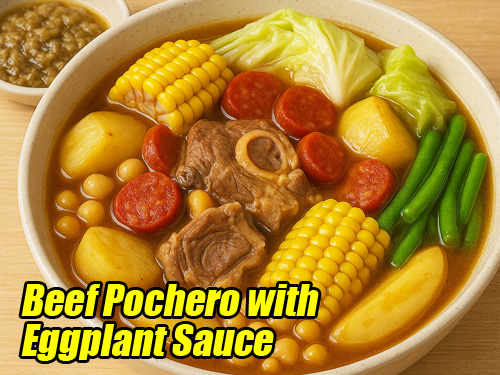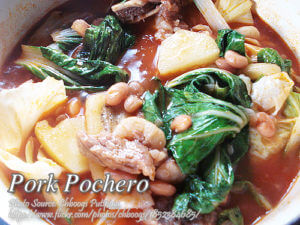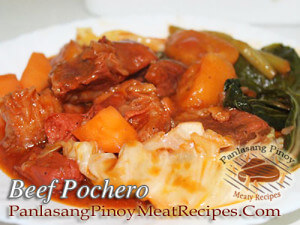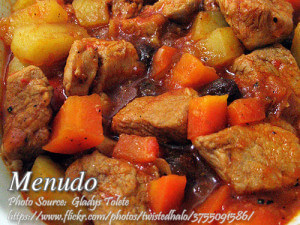Beef pochero dish is a variation of the well known pork pochero. This recipe is actually stewed beef with Chorizo de Bilbao and vegetables which includes cabbage, potatoes, green beans and garbanzos. It is also served with eggplant sauce.
Beef Pochero with Eggplant Sauce
If there’s one dish that always brings me back to lazy Sunday lunches in Tarlac with my Lola Mercy fussing around the kitchen, it’s beef pochero. She would always say, “Ang sikreto sa masarap na pochero, anak, ay nasa sabaw at tiyaga.” And true enough, the patience that goes into stewing the beef until fork-tender and letting the flavors marry in that rich, savory broth—it’s something you just can’t rush.
I remember the first time I tried cooking this hearty stew myself. It was during my college days in Manila, and I called up my Uncle Romy, who worked as a cook for a small carinderia in Quezon City. He rattled off the steps from memory, laughing when I asked if I could use hotdogs instead of Chorizo de Bilbao. “Hindi puwede, iba talaga ang linamnam ng Chorizo de Bilbao,” he said. And he was right. That smoky, garlicky sausage adds a depth that regular meat can’t match.
What Makes This Beef Stew Special
Unlike the more commonly known pork pochero, this version uses beef kenchi—beef shank with the bone and marrow intact. This cut is perfect for slow cooking, and it gives the broth that gelatinous richness we Filipinos love. Toss in potatoes, green beans, cabbage, and sweet bananas, and you’ve got a full meal in a bowl. It’s rustic, comforting, and deeply flavorful.
What sets this apart even more is the eggplant sauce served on the side. At first, it might seem like an odd pairing, but once you spoon a little of that smoky, garlicky sauce over the stew, you’ll wonder why it’s not served with every meat dish. My cousin Letty, who lives in Batangas, actually taught me how to blend the sauce just right—roast the eggplants until their skins are charred and soft, then mash them with vinegar, garlic, salt, and a touch of fish sauce. It’s bold, earthy, and balances out the richness of the beef.
A Bit of History Behind This Classic Dish
Pochero, or puchero, has Spanish roots and was introduced to Filipino kitchens during the colonial period. The word itself comes from the Spanish puchero, meaning stew pot. It was originally a dish made from leftover meats and vegetables, stretched out with broth to feed big families. Over time, we adapted it with local ingredients—saging na saba, patis, and even bagoong for some regional versions.
What I love about this dish is how versatile it is. Every household seems to have their own take. In my friend Joan’s home in Iloilo, they add leeks and tomato sauce to the broth. In Pampanga, my Ninang Celia prefers to use bone marrow for a richer taste. But no matter the variation, one thing remains: it’s always a dish that brings people together.
How to Make a Comforting Bowl of Beef Pochero
Cooking this stew doesn’t require much technique, but timing is key. You start by boiling the beef kenchi and Chorizo de Bilbao in water with a generous pinch of salt. This step tenderizes the meat and extracts the flavor into the broth. Once the meat is fork-tender, take it out and cook the vegetables—starting with the hard ones like potatoes, then green beans, cabbage, and lastly the bananas. Each should be cooked just right—not mushy, not raw.
Separately, sauté garlic and onions in hot oil. This simple step builds flavor. Once aromatic, pour in some of the reserved broth and season to taste. Return the meat and vegetables to the pan, toss in the garbanzos, and let it simmer just enough to bring everything together.
Why does this method work? Because layering the ingredients this way keeps each component’s texture intact. It also makes the dish taste clean but deeply savory—nothing is overcooked, and every bite is full of character.
Serve It Right with Eggplant Sauce
Now here’s the fun part. The eggplant sauce. I used to skip this part, thinking the stew was enough. But my brother Jun, after spending time in Nueva Ecija for work, came back swearing by it. He said it reminded him of baba ghanoush but with a Pinoy twist.
To make it, you roast the eggplants until blistered and soft. Then you blend or mash them with vinegar, minced garlic, a bit of salt, and patis. The smoky tang of the sauce cuts through the richness of the stew and makes each spoonful more exciting.
So next time you’re craving something hearty and soul-warming, try making this version of beef pochero. It’s not just food—it’s a taste of home, memory, and Filipino ingenuity.
How to Cook Beef Pochero with Eggplant Sauce
Ingredients
- 1/2 kilo beef kenchi or shank cut into serving pieces
- 1 small can Chorizo de Bilbao sliced
- 6 cup water
- 1/2 head medium-sized cabbage quartered
- 100 grams green beans
- 2 pcs medium-sized potatoes quartered
- 2 pc banana saba variety sliced diagonally
- 1 small can garbanzos
- 3 cloves garlic minced
- 1 medium-sized onion sliced
- 4 cup broth from boiled beef and vegetables
- 1/2 tsp. MSG
Eggplant sauce Ingredients:
- 2 eggplant broiled, peeled and smashed
- Salt and pepper to taste
- 1/2 cup vinegar
- 1/2 tsp. garlic minced
Instructions
How to cook Beef Pochero with Egg Plant Sauce:
- Boil beef kenchi and Chorizo de Bilbao in water and salt.
- When tender, remove, and cook potatoes, green beans, cabbage, and bananas in the same broth. Set aside.
- Saute garlic and onions in hot oil. Add broth and seasoning, then put in meat, potatoes, green beans, cabbage, bananas, and garbanzos. Cook for a few minutes then serve with eggplant sauce.
How to prepare the Eggplant Sauce:
- Blend ingredients together and serve with beef pochero.
Notes
Cooking Tips:
Choose the Right Cut of Beef
Use beef shank or kenchi for the best flavor and texture. This cut becomes tender after slow simmering and adds richness to the broth from the marrow. Avoid lean cuts, as they can turn dry and chewy when stewed for long periods.Don’t Overcook the Vegetables
Cook your vegetables in stages, starting with the firm ones like potatoes and ending with cabbage and bananas. This keeps them from becoming mushy and helps preserve their individual textures. Overcooked veggies can make the broth cloudy and alter the overall taste.Make the Eggplant Sauce Ahead
Roast and blend your eggplant sauce before starting the stew so the flavors have time to develop. Letting it sit for a while enhances the garlic and vinegar notes, making it more vibrant. Serving it slightly chilled also adds a refreshing contrast to the warm stew.





